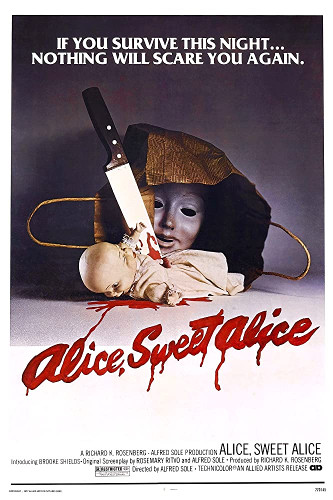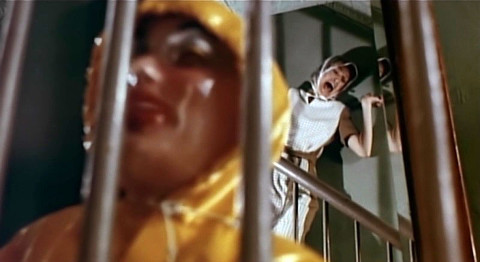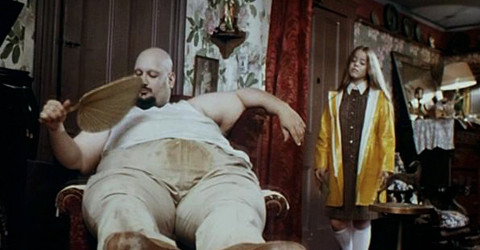Alice Sweet Alice (1976)
Directed by: Alfred Sole
Written by: Alfred Sole, Rosemary Ritvo
Starring: Linda Miller, Mildred Clinton, Niles McMaster, Paula E. Sheppard
AKA COMMUNION, HOLY TERROR
US
AVAILABLE ON BLU-RAY AND DVD
RUNNING TIME: 107 mins/106 mins
REVIEWED BY: Dr Lenera
Paterson, New York, 1961. Alice Spages is a withdrawn 12-year-old girl who lives with her younger sister Karen and their mother Catherine. Karen gets most of Karen’s attention, and the jealous Alice is often left out of the spotlight and in retaliation makes life difficult for Karen. On the day of her first communion, Karen is strangled to death in the church transept by a person wearing a translucent mask and a yellow raincoat. After Karen’s funeral, Catherine’s ex-husband Dominick begins independently investigating her murder, while Detective Spina formally handles the case. Everyone seems to suspect Alice except for her mum and dad, but surely a young girl couldn’t be that strong and brutal?….
I was about twenty minutes into this really unsettling, atmospheric and well written combination of mystery, shock and offbeat family drama before I almost said out loud, “why have I not SEEN this movie before”?, something that happened several times afterwards too. I even remember it being shown on TV several times when I was very young under its original UK cinema release title Communion, but for some reason this was not one of those movies that I sneaked downstairs illicitly to watch after my parents had gone to bed. It seems to be well regarded critically and has a good reputation in more culty horror circles as both a good early slasher movie before the boom commencing with Halloween began, and an impressive American attempt at a giallo [though director Alfred Sole says that his primary influence and inspiration was Don’t Look Now], but it still seems to have slightly fallen between the cracks amidst all the other great horror movies that were coming out around the same time. Like indeed many gialli it’s a pretty heavy jab at the Catholic church, yet it also has a dark sense of humour which strangely doesn’t mute the horrifying elements or its message. It has some terrific kills and moments of violence which have a real nastiness to them even though we’ve all seen far more graphic scenes of a similar nature, yet it’s also about a lonely, neglected child with serious psychological problems which is something of an indictment of parents who really should pay more attention to their offspring. It’s wordy, but I wasn’t shuffling on my settee at all because of the way that virtually every character, even very minor, was well drawn.
Sole began writing this in 1974 with Rosemary Ritvo, culling much of the family drama and dynamics from his own Italian-Catholic upbringing, while Mrs. Tredoni was based on a woman who lived at the Catholic rectory next-door to his grandmother’s house. The inexperienced filmmaker didn’t have a casting director, so instead he approached various stage actors. Alphonso De Noble was cast as the sleazy landlord Mr. Alphonso after director Sole had seen him impersonating a priest, saying prayers to get money off the bereaved in local cemeteries. The film was primarily shot in Paterson, New Jersey. The production was periodically postponed during filming, because two to four week breaks would be taken due to budget issues, during which the production sought out additional funding. On one occasion it was because star Linda Miller, with whom Sole clashed repeatedly, attempted suicide by slitting her wrist. Because of all this, the production had to recurrently hire new cameramen which ended up being nine in total. Columbia were going to be the American distributors, but, following a dispute over money between the studio and producer Richard Rosenberg, they dropped it and Allied Artists picked it up. Though originally entitled Communion, Allied Artists got the title changed to Alice, Sweet Alice [which Sole hated] for US release, then it was changed again for a re-release in 1981 to cash in on the popularity of The Blue Lagoon, even though Shields is only in it for about 20 minutes. It did okay business. Videos were seized in the UK during the Video Nasty nonsense though it was never on the DPP’s list. Sole’s failure to keep the copyright meant that it got poor public domain releases until 1997 when Sole removed a minute and half which allowed him to copyright this version, though most subsequent versions were uncut, not including the 1998 UK video which lost three seconds of a squirming kitten being swung at an attacker, an edit later extended to eight seconds for the 2003 DVD.
The opening titles certainly set the right mood as a plaintive musical theme that becomes indistinct whispering is heard over an image of a woman in communion garb holding a crucifix revealed to be the handle of a knife. We are in the house of Catherine Spages and her two daughters Alice and Karen. It’s nearly Karen’s communion and Father Tom is round, but Alice hates all this attention that her sister is getting so she frightens her with a mask, ruins her communion head piece, and takes away her doll so she can lure her to an abandoned house where she locks her in a room then says that she’ll break the doll [which is a truly hideous thing, frankly she’d be doing her a favour I reckon] if Karen tells mum. I’d have been satisfied if the whole film was about this sibling rivalry, a sort of juvenile Whatever Happened To Baby Jane, where you both feel sorry for – indeed almost identify with – Alice yet are just a little scared of her. Paula Sheppard, who went on to make just one more film – another cult favourite Liquid Sky – before retiring from acting, was actually 19 years old when she made this film, but you wouldn’t know it, so convincing is she as Alice aided by some excellent makeup. Brooke Shield just doesn’t compare whatsoever but that’s probably no surprise even if you allow for the fact that she was several years younger. There’s a minor jolt when Alice removes her mask to reveal another underneath, but it’s not long before Karen is strangled to death in the church transept by a person wearing the same mask and a yellow raincoat. Her body is stuffed into a bench compartment near the confessionals which is then set on fire with a candle, but not before her crucifix is ripped from her neck. Even when it’s inter-cut with the church service, it’s quite grim because seeing children killed always carries an extra charge of nastiness. Alice enters the church carrying Karen’s veil and kneels in place to receive communion. Simultaneously, a nun who has noticed smoke coming from the transept locates Karen’s body and screams in horror, disrupting the ceremony which descends into a frenzied panic!
Alice doesn’t seem too upset by her sister’s murder, and as various parties investigate Detective Spina and Father Tom come to believe that she could have actually done it. After all, she did hate Karen. The script is quite clever in the way that it hints repeatedly that Alice could be the culprit which of course seems to suggest that it could never really be her, it’s too daft – which is precisely why we think that the film might actually go as far as to eventually reveal her as the killer. Eventually, an attempt at another murder pretty much tells us that it couldn’t be her, even if this particular murderer has serious trouble dragging bodies along in one of several nice changes from the norm. Then soon after that the film does something else that’s very unusual indeed; it reveals the real culprit about three quarters of the way through, then lets us follow this person as more murder is planned, and actually invites to have some empathy for him/her [perfectly balanced performance by the thespian in question here]. Everything’s all coming together so well that the low-key vein of dark humour which has threatened to surface throughout is now allowed to properly reveal itself, notably when the killer is hiding in the confession box and has to make up some stuff to Father Tom who sees that somebody is in there, and when the next victim-to-be is targeted by both Alice and the killer. By contrast, viewers used to thrilling fight to the death climaxes may find the finale lacking, but thematically it certainly feels right.
The reason for why this person is doing all this is a little silly [though no more than in a lot of gialli], but then said reason fits in with the general attack on Catholicism. While it stops short of demonising all the people who serve it by having Father Tom be a sympathetic character, the film still seems to be saying that by repressing human sexuality, and also by favouring some people in lieu of others [I’ve been a lapsed Catholic since I was a teenager and remember hating the way that if you weren’t in the right clique you were worth almost nothing], the Church creates and even encourages all other kinds of problems. But in terms of its characters it’s not always that black and white. We’re presented with too hugely unpleasant people – Alice’s overbearing aunt Annie DeLorenze and Mr. Alphonso the repulsive landlord who continually listens to the music from ‘Showboat’ and who tries to molest Alice in a scene almost as uncomfortable as the bloody moments. But everyone else seems to have equal good and bad points. Take Catherine; the film certainly criticises her for not paying attention to Alice and hints that her attitude has even created Alice’s psychological issues, but we also see a mother desperately trying to keep it together as things get worse and worse, Linda Miller [certainly not the one in King Kong Escapes] being truly fine and sometimes quite moving in the part. And when we finally get a scene where, after being cold to each other for so long, mother and daughter finally embrace, it’s genuinely touching and really feels earned. Everyone in this film seemed like they actually lead a life, from Detective Spina to Alice’s father Dominick, even if not all of the smaller performances quite come off. And when ex-husband and wife almost get it on, it feels believable for a change, and can be related to the other major theme of the film – that old Catholic favourite – guilt.
Even if you didn’t know it, one can easily guess by the killer’s yellow mac and certain scenes, even shots, that Don’t Look Now was an influence. But the mask is a doozy, and you’ve got to love the white gloves worn instead of the usual giallo black. There aren’t many kills and the biggest shock [watch out for the first of two stair sequences that would make Alfred Hitchcock jealous] is for a murder try that isn’t even finished. But there’s something distinctly uncomfortable about them, and I don’t necessarily mean the way they reflect Christian imagery – in fact the use of constant religious statues, paintings, crosses, rosaries etc. is maybe a little over the top even though I very much liked it. And many of the quieter scenes have a slight and strange edge to them because of the way they’re filmed. Angles are sometimes strange and makes the actors look somehow sinister, while edits and scene transitions are often jarring, something which could be partly put down to the fact that the production ran out of money and many pick-up shots had to be taken from material previously filmed – yet it works for this particular film. In church, everyone seems cramped, even trapped. In fact people look hemmed in by the interiors throughout, something aided by what looks like the continual use of wide angle lenses – while outside it’s usually raining. The drab, brown-heavy look is hardly appealing but of course makes the red stand out, while the stock used for filming must really have been cheap as the Blu-ray didn’t look too great. Stephen J. Lawrence’s music score piles on the screeching violins and eerie female voices and clearly riffs on Psycho in a few places. It’s a bit overused at first but soon settles in. But overall Alice, Sweet Alice is quite a stunner, though perhaps its real mystery is how a person who directed the terrible slasher spoof Pandemonium could create something this good. I guess I need to see Tanya’s Island, his only other cinema directorial effort [which looks very odd indeed] to make an informed opinion on Sole. In the meantime Alice, Sweet Alice is creepy yet intelligent, cruel yet actually containing a real beating heart. I loved it.
Rating: 














Be the first to comment